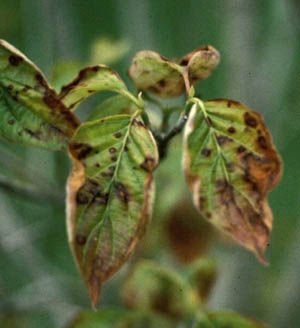Not an Ordinary Anthracnose�� | |
|---|---|
| June 19, 2006 | |
|
We discuss anthracnose of shade trees each spring and usually advise additional cultural practices but no chemical sprays. Early-season shade tree leaf spots are not a major concern in the nursery or the landscape. There is some leaf drop, but trees recover with warmer, drier conditions in Illinois. Dogwood anthracnose is another story. It appears in early summer and can cause leaf spots, stems cankers, and tree decline. Watch for dogwood anthracnose now. Treatment is usually advised to keep this disease in check. Trees in a forest setting are more at risk for injury. In Illinois, we tend to use our dogwoods as specimen trees in the landscape. Such sites are usually exposed to sun and a good amount of air movement, helping foliage dry quickly. It is important to be aware of disease symptoms to make an early diagnosis and initiate the proper controls. Dogwood anthracnose is caused by the Discula fungus and is usually referred to as Discula anthracnose to avoid confusion with spot anthracnose, a minor disease of dogwood. The two are easily confused. The spot anthracnose fungus infects leaves, young shoots, and fruit. It causes small spots with purple borders. Discula anthracnose causes leaf spots and stem cankers, and may kill shoots. The infected leaves may have brown spots with (purple borders) that are usually larger than those of spot anthracnose (1/2-inch versus 1/4-inch diameter). The edges of the leaves may be necrotic. This necrotic area may spread until the entire leaf is dead. Brown leaves often remain attached for a month or more. An image of dogwood leaves infected with anthracnose follows.  If you suspect that leaf symptoms resemble Discula anthracnose, examine larger branches for cankers by peeling back the bark in infected areas. Look for twig dieback, especially in the lower crown. Under very humid conditions, infected leaves and twigs produce tiny fruiting bodies with masses of spores, used to confirm the disease in the lab. The Plant Clinic is able to test for anthracnose with a one-day turn around. If you suspect that leaf symptoms resemble Discula anthracnose, examine larger branches for cankers by peeling back the bark in infected areas. Look for twig dieback, especially in the lower crown. Under very humid conditions, infected leaves and twigs produce tiny fruiting bodies with masses of spores, used to confirm the disease in the lab. The Plant Clinic is able to test for anthracnose with a one-day turn around.Discula anthracnose is difficult to control once it has caused significant dieback in a tree. Maintain optimal conditions for growth and recovery, which involves watering during drought stress of 2 weeks, avoiding overhead irrigation, applying a mulch over the root system, and improving air movement around trees (through pruning of surrounding vegetation) to minimize infections and encourage drying of foliage. Prune and discard infected branches and shoots. Rake up fallen leaves. Avoid high nitrogen fertilization that encourages succulent, susceptible vegetation. Protective fungicides are available to help manage this disease. Consult the Illinois Commercial Landscape and Turfgrass Pest Management Handbook or the Home, Yard, and Garden Pest Guide for a list of registered fungicides. Trade names, active ingredients, mobility information, and company names are listed in a table at the end of the appropriate chapter.�� | |
| Author: | Nancy Pataky |
